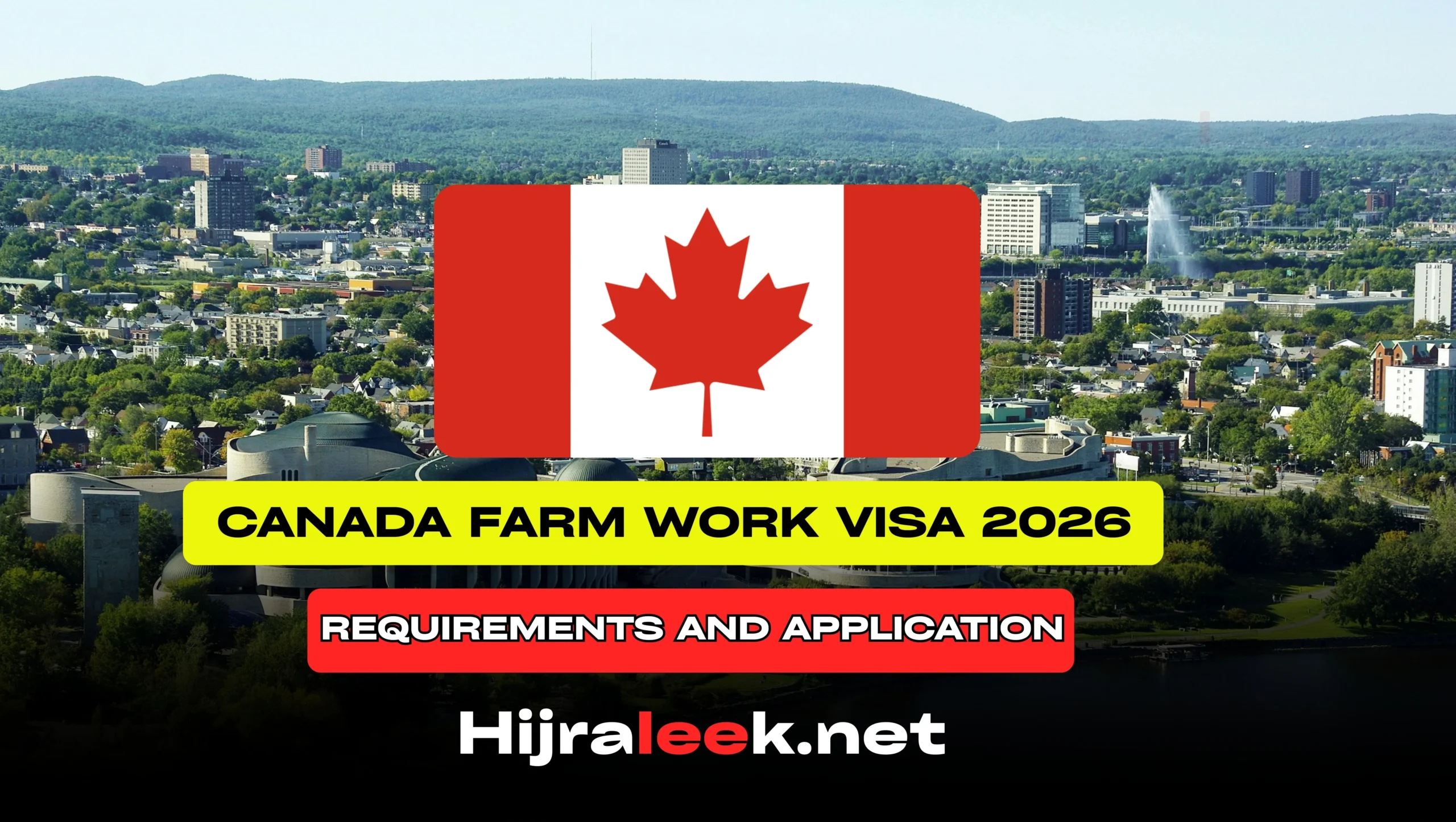The Canada Farm Work Visa 2026 offers a significant opportunity for international workers to contribute to Canada’s thriving agricultural sector, addressing critical labor shortages in farming, livestock, and food production. With Canada being a global leader in agriculture, producing crops like wheat, canola, and fruits, as well as dairy and poultry, the demand for farm workers remains high. This comprehensive guide, tailored to the keyword Canada Farm Work Visa 2026, provides a detailed overview of the requirements, application process, visa types, costs, salaries, benefits, challenges, and resources for securing farm jobs in Canada. Whether you’re a seasonal worker or seeking long-term employment, this 2000-word guide equips you with the knowledge to navigate the process successfully.
Introduction to Canada Farm Work Visa 2026
Canada’s agricultural industry is a cornerstone of its economy, contributing over $110 billion annually to the GDP. The Canada Farm Work Visa 2026 facilitates the entry of foreign workers to fill labor gaps in primary agriculture, particularly in rural areas where local workers are scarce. Programs like the Seasonal Agricultural Worker Program (SAWP) and the Temporary Foreign Worker Program (TFWP) enable employers to hire international talent for roles such as fruit picking, dairy farming, and farm management. These visas not only support Canada’s food security but also offer workers competitive wages, cultural immersion, and professional growth opportunities. Platforms like Hijraleek connect applicants with verified Canadian employers, making the job search more accessible.
Why Canada Needs Farm Workers in 2026
Canada faces chronic labor shortages in agriculture due to an aging workforce, rural-to-urban migration, and seasonal demands. According to the Royal Bank of Canada, the sector could face a shortage of 123,000 workers by 2030. In 2026, the demand for farm workers is expected to peak during planting (March–May) and harvesting seasons (August–October), particularly for fruits, vegetables, and greenhouse crops. The Jubilee 2026, a global Catholic event, may also increase tourism and food demand, further necessitating agricultural labor. Programs like SAWP and TFWP ensure farms can operate efficiently, producing high-quality crops and livestock for domestic and export markets.
Who Can Apply for the Farm Work Visa?
The Canada Farm Work Visa 2026 is open to non-Canadian citizens, primarily from non-EU/EEA countries, with specific eligibility varying by program:
- SAWP: Restricted to citizens of Mexico and 11 Caribbean countries (e.g., Jamaica, St. Kitts-Nevis, St. Vincent and the Grenadines).
- TFWP: Open to nationals from any country, provided they have a job offer from a Canadian employer.
- General Eligibility: Applicants must be at least 18, have a valid job offer, and meet health and character requirements. No formal education is typically required for low-skill roles, making these visas accessible to a wide range of candidates.
Types of Farm Work Visas in Canada 2026
Canada offers two primary visa programs for farm workers, each tailored to specific agricultural needs.
Seasonal Agricultural Worker Program (SAWP)
The SAWP allows employers to hire temporary foreign workers from Mexico and participating Caribbean countries for seasonal agricultural jobs (up to 8 months, January 1–December 15). Key features include:
- Eligibility: Citizens of Mexico, Jamaica, Barbados, Trinidad and Tobago, and other Caribbean nations.
- Duration: Maximum 8 months, with a minimum of 240 hours of work within 6 weeks.
- Job Types: Primary agriculture (e.g., fruit picking, vegetable harvesting, apiary work, livestock care).
- Benefits: Employer-provided housing, round-trip transportation, and private health insurance until provincial coverage applies.
- Flexibility: Workers can transfer between SAWP employers without a new work permit, provided the employer has a valid Labour Market Impact Assessment (LMIA).
Temporary Foreign Worker Program (TFWP)
The TFWP covers both seasonal and non-seasonal agricultural jobs and is open to workers from any country. Key features include:
- Eligibility: No nationality restrictions, but a job offer and LMIA are required.
- Duration: Varies by job contract (typically 6 months to 2 years).
- Job Types: Includes low-skill (e.g., farmhands, harvesting laborers) and high-skill roles (e.g., farm supervisors, NOC codes 80020, 82030).
- Employer-Specific: Work permits are tied to a single employer, requiring a new permit to change employers.
Both programs require employers to obtain a positive LMIA, confirming no Canadian workers are available, ensuring fair wages and conditions aligned with Canadian standards.
Eligibility Requirements for Canada Farm Work Visa 2026
To qualify for the Canada Farm Work Visa 2026, applicants must meet specific criteria, which vary slightly between SAWP and TFWP.
Age and Health Conditions
- Age: Applicants must be at least 18. There’s no strict upper age limit, but employers may prefer candidates under 55 for physically demanding roles.
- Health: A medical examination is required for roles involving food processing or livestock handling, or if staying over 6 months (e.g., from designated countries like India). The exam, conducted by a panel physician, ensures no public health risks. Applicants must be physically fit for labor-intensive tasks like harvesting or animal care.
Education and Skills Needed
- Education: No formal education is required for low-skill roles (NOC Skill Level C or D, e.g., general farm workers, fruit pickers). Skilled roles (e.g., farm managers, NOC 80020) require recognized qualifications, such as a diploma in agriculture, verified via the Canadian Information Centre for International Credentials (CICIC).
- Skills: Experience in farming or agriculture (e.g., planting, harvesting, machinery operation) is preferred but not mandatory for SAWP or low-skill TFWP roles. Skilled positions require 2–5 years of relevant experience.
Language Requirements (English or French)
- Language Skills: No formal language test (e.g., IELTS) is required for low-skill farm jobs (NOC Skill Level D). However, basic proficiency in English or French is necessary for workplace communication, as Canada is bilingual. Employers may assess this during interviews. For skilled roles, a minimum CLB 4 (equivalent to IELTS 4.0–5.0) may be preferred, though not mandatory.
Documents Required for Application
A complete application ensures faster processing. Below are the essential documents for the Canada Farm Work Visa 2026.
Valid Passport and Photos
- Passport: Must be valid for the entire work period, with at least two blank pages. Include copies of the photo page and any relevant visas.
- Photos: Two recent passport-sized photos (35mm x 45mm, white background, ISO/IEC format) are required for the visa application.
Job Offer from a Canadian Employer
- Employment Contract: A signed contract from a Canadian employer detailing the job role, salary, duration, and conditions (e.g., housing, transport). The employer must provide a positive LMIA, obtained from Employment and Social Development Canada (ESDC).
- Job Offer Letter: Specifies the position (e.g., NOC 85101 for harvesting laborers) and confirms compliance with Canadian labor standards.
Medical Exam and Police Certificate
- Medical Exam: Required for workers from designated countries (e.g., Mexico, India) or roles involving food/livestock. Book with an IRCC-approved panel physician 1–2 months before applying. Cost: $150–$300.
- Police Certificate: A criminal record check from your home country (and any country of residence for over 6 months in the past 5 years), apostilled if required. Cost: $20–$100, depending on the country.
Step-by-Step Application Process
Securing a Canada Farm Work Visa 2026 involves coordination between the worker, employer, and Immigration, Refugees and Citizenship Canada (IRCC).
How to Find a Farm Job in Canada 2026
- Job Platforms: Use Hijraleek, Job Bank Canada, Indeed Canada, or AgCareers to find farm jobs with visa sponsorship.
- SAWP Applicants: Contact your country’s Ministry of Labour (e.g., Mexico, Jamaica) for recruitment into SAWP. Employers coordinate with foreign governments to select workers.
- Regions: Focus on Ontario (fruit, vegetables), British Columbia (berries, vineyards), and Quebec (dairy, maple syrup).
Online Visa Application Process
- Secure a Job Offer: Obtain a signed contract and LMIA from the employer.
- Gather Documents: Prepare passport, photos, job offer, LMIA, medical exam (if required), and police certificate.
- Create an IRCC Account: Register on the IRCC Portal for online submission.
- Complete Application: Fill out the work permit application (IMM 1295 for TFWP, SAWP-specific forms via employer). Upload documents and pay fees.
- Biometrics: Book an appointment at a Visa Application Centre (VAC) for fingerprints and photos ($85 CAD). You’ll receive a Biometric Instruction Letter (BIL) after applying.
- Submit Application: Submit online via the IRCC Portal. Ensure all fields are accurate to avoid delays.
Processing Time and Approval
- Processing Time: 8–12 weeks for SAWP (prioritized for essential services); 5–36 weeks for TFWP, depending on the country and application completeness. Apply early (late 2025 for spring 2026 jobs).
- Approval: If approved, you’ll receive a Port of Entry (POE) Letter of Introduction. Present this with your passport upon arrival in Canada to receive the work permit.
Cost of Applying for Canada Farm Work Visa 2026
Understanding costs is crucial for budgeting your application.
Government Fees
- Work Permit Fee: $155 CAD per person (TFWP and SAWP).
- Biometrics Fee: $85 CAD (one-time for 10 years, covers fingerprints and photo).
- LMIA Fee: $1,000 CAD, paid by the employer, not the worker. Employers cannot charge recruitment fees.
Other Expenses (Medical, Travel, etc.)
- Medical Exam: $150–$300 CAD, depending on the country and clinic.
- Police Certificate: $20–$100 CAD, varying by country.
- Travel Costs: Round-trip flights (e.g., $500–$2,000 CAD from Mexico or India). Employers cover round-trip transport for SAWP workers.
- Health Insurance: SAWP employers provide private insurance until provincial coverage applies; TFWP workers may need to purchase initial coverage ($100–$200 CAD).
Salary and Benefits for Farm Workers in Canada 2026
Farm jobs in Canada offer competitive wages and benefits, especially with employer support.
Average Farm Worker Salary in Canada
- Low-Skill Roles (NOC C/D): $15–$20/hour (e.g., fruit pickers, farmhands). Monthly: $2,400–$3,200 CAD (40-hour weeks).
- Skilled Roles (NOC A/B): $20–$30/hour (e.g., farm supervisors, agricultural technicians). Monthly: $3,200–$4,800 CAD.
- Ontario Minimum Wage (2026): Expected at $17.60/hour for most agricultural roles.
Housing, Food, and Transportation Support
- Housing: SAWP employers must provide free or affordable housing (max $30/week deduction, except in British Columbia). TFWP employers often provide subsidized housing.
- Food: Some employers offer meals or kitchen access as part of the contract.
- Transportation: SAWP employers cover round-trip travel (e.g., flights from Mexico). Both programs require employers to arrange transport between housing and worksites.
Challenges and Tips for Success
Navigating the Canada Farm Work Visa 2026 process can be complex, but preparation mitigates challenges.
Common Mistakes to Avoid During Application
- Incomplete Documents: Missing LMIA, medical exam, or police certificate delays processing. Double-check requirements on IRCC.
- Incorrect Job Codes: Ensure the job offer matches the correct NOC code (e.g., 85101 for harvesting laborers).
- Ignoring Visa Conditions: SAWP workers must leave by December 15; TFWP workers cannot switch employers without a new permit.
Tips for Fast Visa Approval
- Apply Early: Submit by late 2025 for spring 2026 jobs to account for 8–12-week processing.
- Use Trusted Platforms: Find jobs via Hijraleek or Job Bank Canada to avoid scams.
- Ensure Employer Compliance: Verify the employer has a valid LMIA and is registered with ESDC.
- Complete Medicals Early: Book medical exams 1–2 months before applying to avoid delays.
- Track Application: Use the IRCC Portal to monitor status and respond promptly to additional requests.
Useful Resources and Official Links
Access reliable resources to streamline your application for the Canada Farm Work Visa 2026.
Government of Canada – Immigration Website
- IRCC: Official site for visa applications, forms, and updates on SAWP and TFWP requirements.
- ESDC: Information on LMIA and employer obligations.
Job Bank Canada for Farm Jobs
- Job Bank Canada: Lists farm jobs with visa sponsorship, searchable by NOC codes (e.g., 85101, 82030).
- Hijraleek: Connects workers with verified Canadian agricultural employers.
Conclusion
The Canada Farm Work Visa 2026 is a gateway to rewarding opportunities in Canada’s agricultural sector, offering competitive wages, employer support, and cultural immersion. Whether through SAWP for seasonal roles or TFWP for diverse agricultural jobs, early preparation, accurate documentation, and trusted platforms like Hijraleek are key to success. By understanding eligibility, costs, and challenges, you can navigate the process confidently.
Why 2026 is the Best Year to Apply
With heightened demand due to labor shortages and events like the Jubilee 2026 boosting food production needs, 2026 is an ideal year to apply. Canada’s streamlined visa processes, priority for agricultural workers, and robust worker protections make it a prime time to join the sector. Start your journey today using IRCC, Job Bank Canada, and Hijraleek to secure your Canada Farm Work Visa 2026.




















